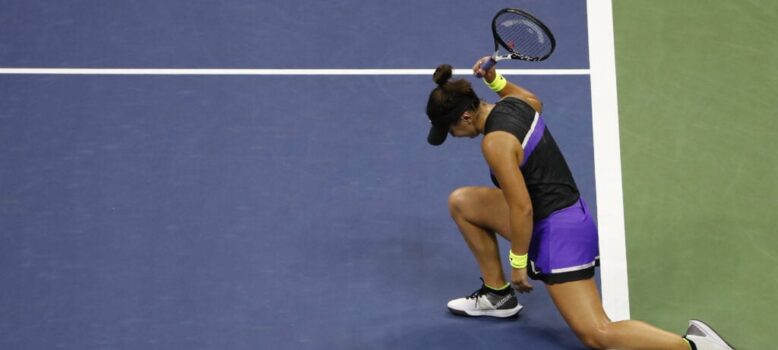

Bianca Andreescu’s historic, game-changing, soaring, magnificent, and utterly unforgettable 2019 tennis season — an immortal year in the pantheon of Canadian sports — is over.
(It will definitely end Friday if Andreescu plays Elina Svitolina. Andreescu cannot reach the semifinals. Bianca’s season could and should end Thursday if she makes what ought to be an obvious decision to not continue in the tournament.)
Andreescu pulled up in pain early in her second match of the WTA Finals in Shenzhen, China, on Wednesday against Karolina Pliskova, after needing a medical timeout in her first match on Monday against Simona Halep.
Andreescu-Halep was a quality match through two sets, but those two sets — played on a slow, high-bouncing court which made it much harder for players to end points quickly — took a physical toll on both players. Halep also needed a medical timeout after the second set of that three-set match. The third set was an ugly, attritional slog in which Andreescu couldn’t fully bend or stretch.
The injury against Pliskova on Wednesday was caused by — drum roll! — bending and stretching for a wide shot near the doubles alley.
The truly alarming part of this story: Andreescu didn’t immediately retire from the WTA Finals. She played several more games and forced Pliskova to win the first set before calling it a day… even though she was in pain.

The player calls the shots in a player-coach relationship in tennis. It isn’t a hard-and-fast reality, but the athlete is more centrally in charge. This is different from team sports (with a few notable exceptions, such as LeBron James carrying more weight in the room than the coach ostensibly assigned to guide him).
Yes, the coach can walk away if s/he is being ignored by the player, but in terms of making final decisions on whether to have a coaching relationship at a given tournament or during a given portion of the tennis season, the player makes the call, not the coach. The coach serves at the pleasure of the player.
If the player isn’t satisfied, the relationship ends. That is the more specific and precise point of differentiation from team sports. The coach or manager runs the ship on the sideline/bench, or in the dugout.
In tennis, the power more fully resides with the player — not to the exclusion of the coach’s input, but certainly more than the coach. It isn’t uniformly a 50-50 dynamic. It CAN be, but not always.
This brings up a very important point about that first set:
Andreescu: "My knee twisted, I heard a crack, she validated me that it’s my mensicus. I can't bend my knee at all. It's cracking every time I walk and it friggin' hurts.”
Bruneau: “Don’t push it.”
Andreescu: “I don’t want to stop.”
LIVE BLOG: https://t.co/BKsfkcbzlB
— WTA Insider (@WTA_insider) October 30, 2019
The knee twisting? A CRACK? A torn meniscus? Andreescu had a sense something was very wrong. Coach Sylvain Bruneau said the responsible thing, but stopped short of insisting that Andreescu shut it down. Andreescu stubbornly played on for several more games.
That is insanity, and Andreescu is lucky nothing more severe happened in those extra games she played.
The best coach-player relationships in any sport involve total trust on both sides. The coach knows when to push the player or loosen up, when to insist that the athlete must do something, and when to allow the athlete to achieve various goals creatively as an autonomous individual.
Both parties in the relationship accept the need to hear — and convey — tough truths when needed.
One of the tougher truths an athlete has to hear is that when hurt, s/he has to stop playing.
Andreescu: “Maybe I could have pushed it more. I don't know. My team said no. It was good that I stopped. Honestly, I could have kept going. If I did, then I would just be, like, whining on the court. I don't want that. I've done that enough.” #WTAFinals
— WTA Insider (@WTA_insider) October 30, 2019
Let’s keep it simple: Bianca Andreescu’s hunger to win is precisely what propelled her through the wear and tear of Indian Wells, Toronto, and the U.S. Open. She encountered significant physical attrition in all three tournaments and powered through to win them all. Andreescu, like any great athlete, knows how to push herself beyond limits other athletes can’t reach. If she wasn’t this driven, she probably wouldn’t be the champion she is.
Yet: There is always a difference between being tough in competition, and foolish in managing one’s body and career.
We saw this from Andreescu and her team when she played Miami after spilling her guts in Indian Wells.
No sane outlook or voice of guidance would have recommended Miami. Yet, Andreescu stubbornly played that tournament.
hopefully they can get the healthy part figured out but 100% right that is priority number 1 through 5 https://t.co/1EAFiEIizz
— Brad Gilbert (@bgtennisnation) October 30, 2019
It cost her the whole clay season and grass season. She played only one match in a fourth-month span.
When she returned to the tour in Toronto, everyone hoped she had learned a lesson or two about limits.
It is unclear that she has.
Sylvain Bruneau is saying the right things, but Andreescu isn’t showing that she is adjusting to the new landscape.
If she wants to be great the next two years, she can throw her body into the fray without concern.
If she wants to have a longer career — and not be the Tracy Austin of 2020 (note how short Austin’s championship career was) — she needs to adjust her thinking and not try to drag her body through pain, as she did against Pliskova.
So, to recap: This conclusion to Andreescu’s season offers multiple reminders. One, trust your coach more. Two, think about the long run more. Don’t always try to be a hero if health is a legitimate concern.
Before we conclude, though, there is a third reminder connected to Andreescu’s story as 2019 comes to a close. This is not something Andreescu must pay attention to. This is something the sport of tennis must listen to:
The Australian Open, Indian Wells, and Miami can be slow hardcourts. Fine. Truly.
However, August-October hardcourt season should be fast hardcourt.
This should be obvious, but tennis just doesn't know how to put 2 and 2 together.
— Matt Zemek (@mzemek) October 28, 2019
You can read the article above at Tennis With An Accent, so I won’t repeat all the details. I will simply say this: Forcing Andreescu and Halep — and everyone else at the WTA Finals — to play slow-court tennis at the end of a long and taxing season is the backward thinking tennis has to eliminate from its decisions and operations.
Bianca Andreescu has to change the way she thinks on several fronts, but in some ways, she was hurt at the WTA Finals for reasons she had no control over. Tennis, not just Andreescu, needs to be smarter, as 2019 ends and we prepare for an exciting 2020 season.
Matt Zemek
Matt Zemek has written about tennis professionally since 2014 for multiple outlets. He is currently the editor of tennisaccent.com and the co-manager of Tennis With An Accent with Saqib Ali. Tennis With An Accent blends Saqib Ali's podcasts with written coverage of professional tennis. The TWAA Podcast hosted Darren Cahill earlier this year. The podcast is distributed by Red Circle and is available on Stitcher, Google Podcasts, and Apple Podcasts. See Matt's pinned tweet on his Twitter page for links to the TWAA Podcast. Matt is based in Phoenix and thinks the Raptors winning the NBA title was awesome. Saqib will be covering Montreal for Tennis With An Accent.









